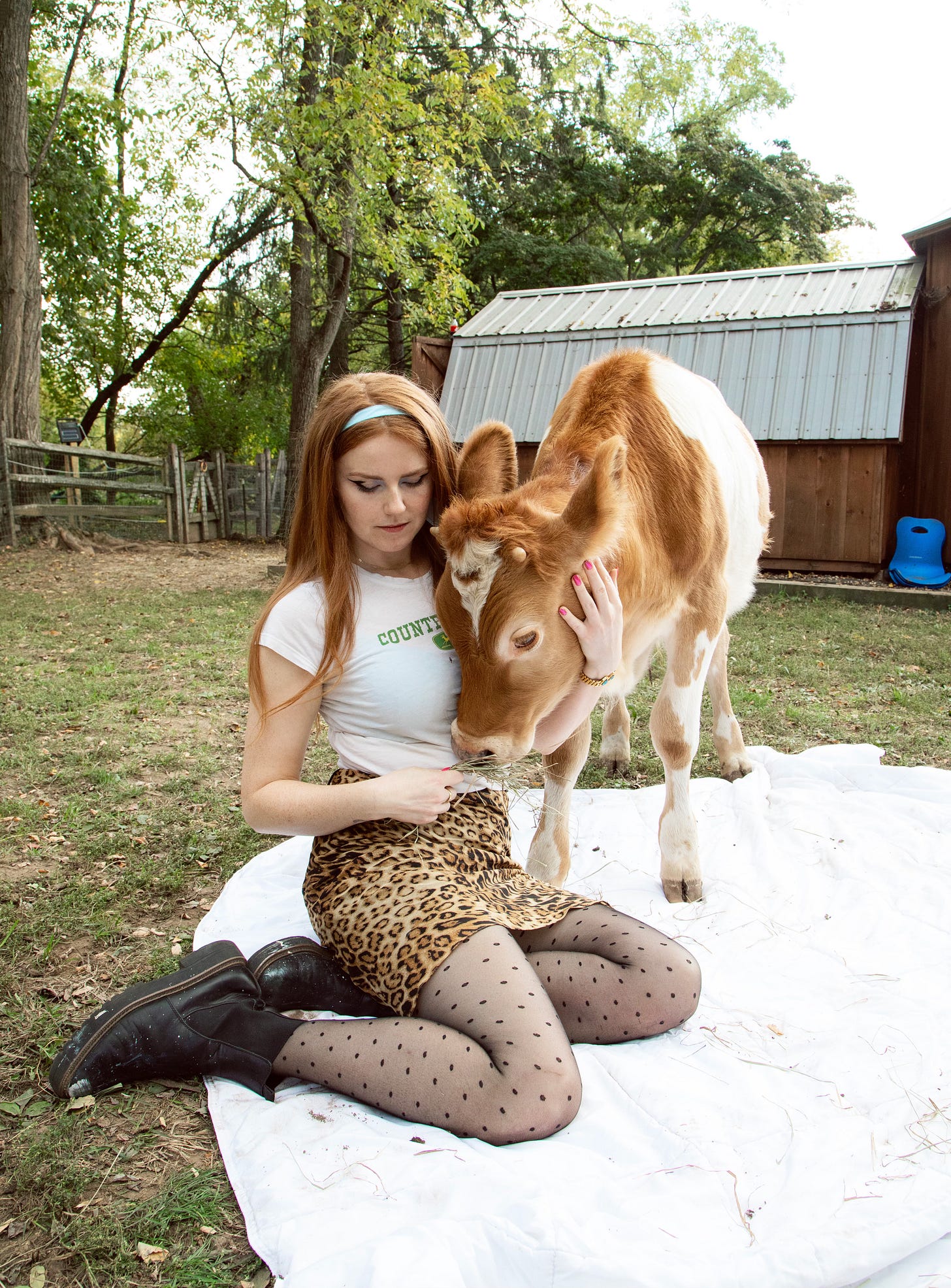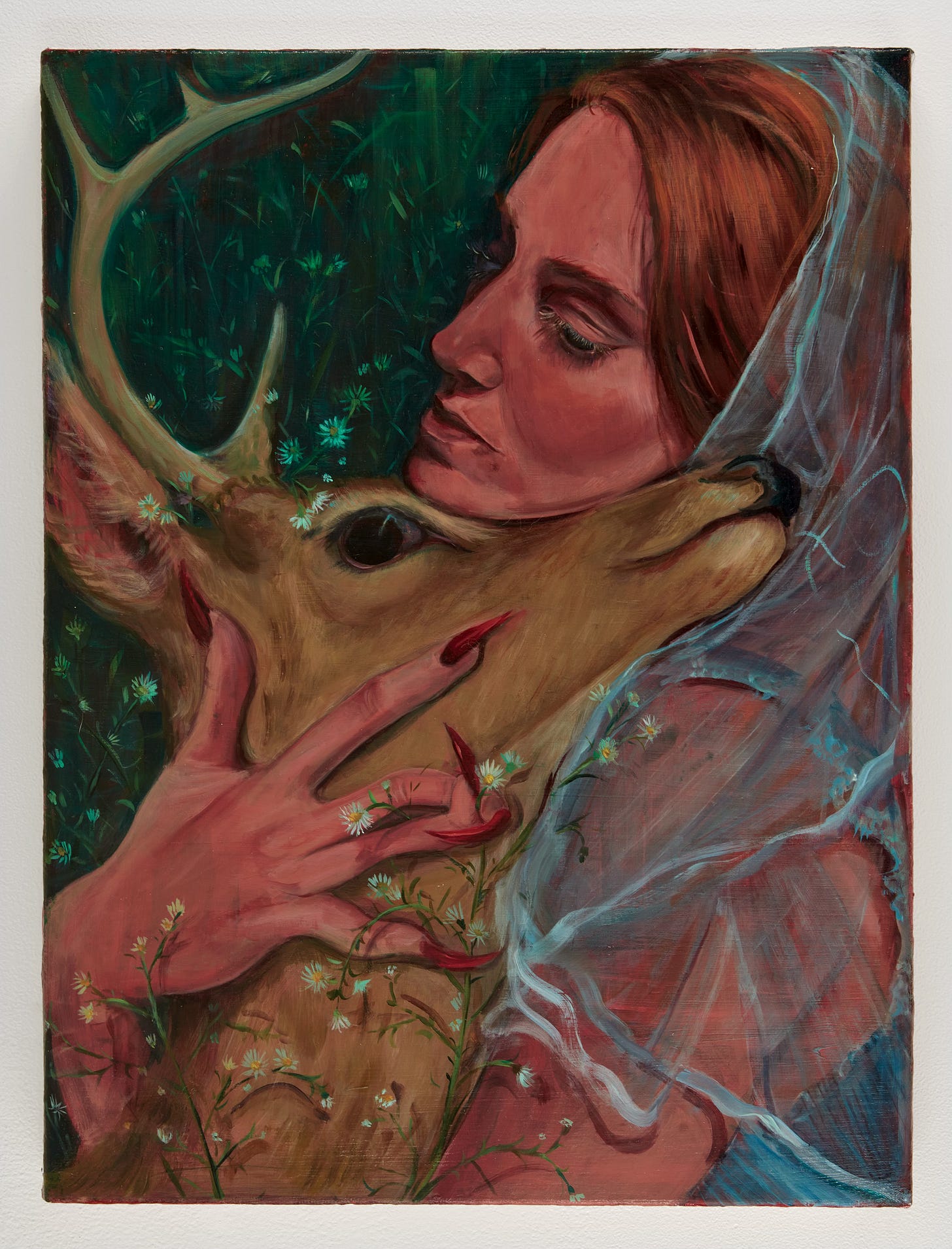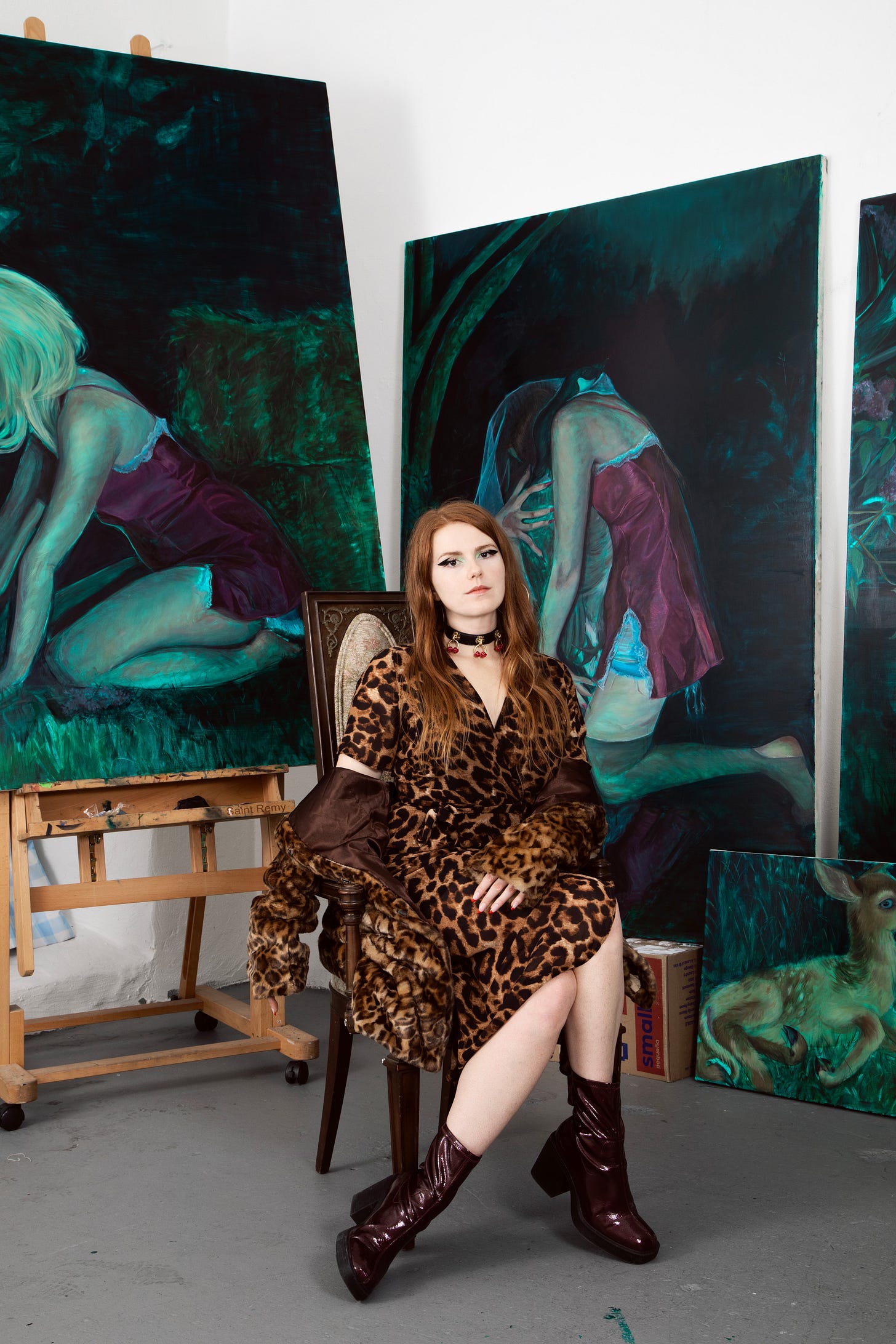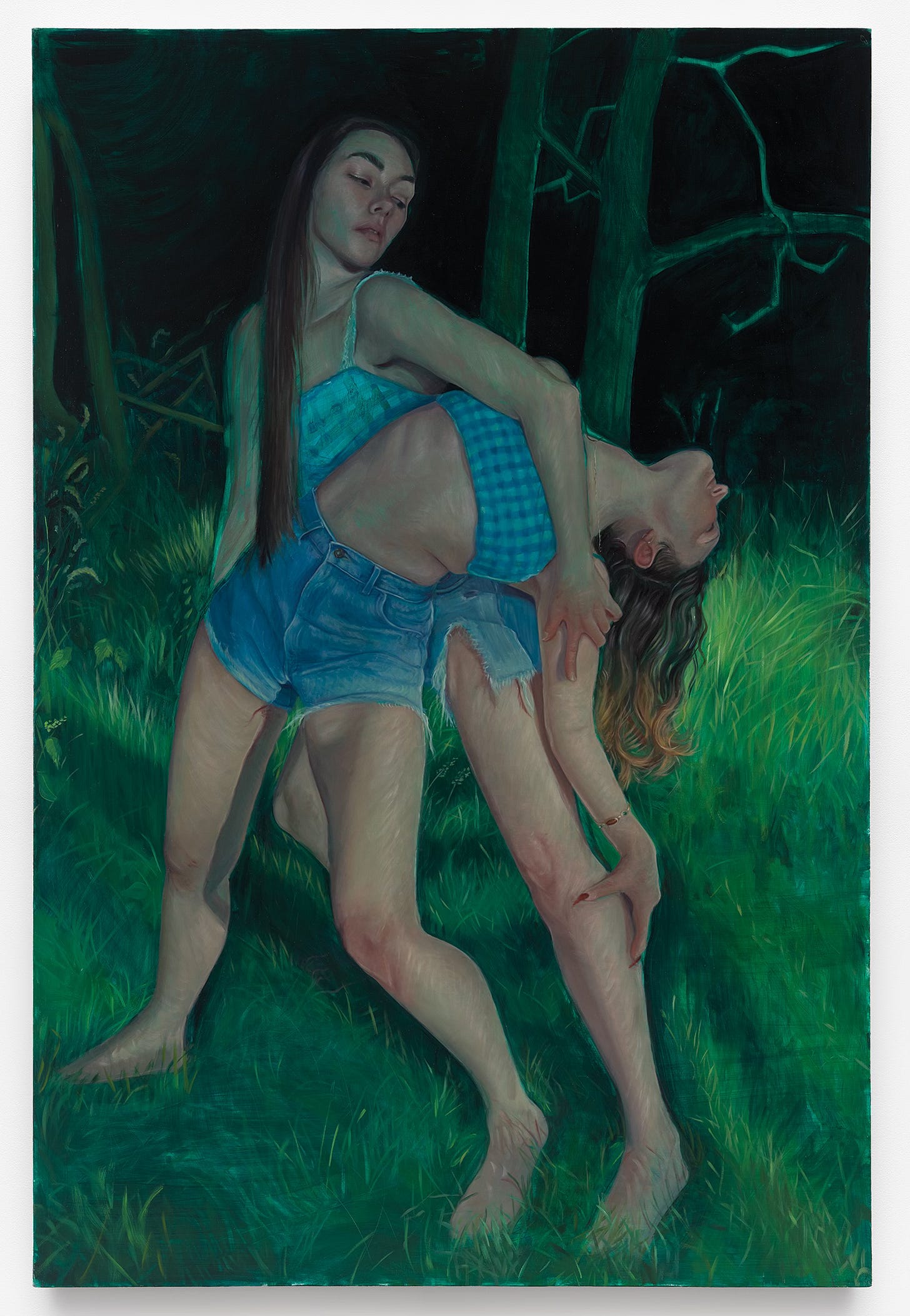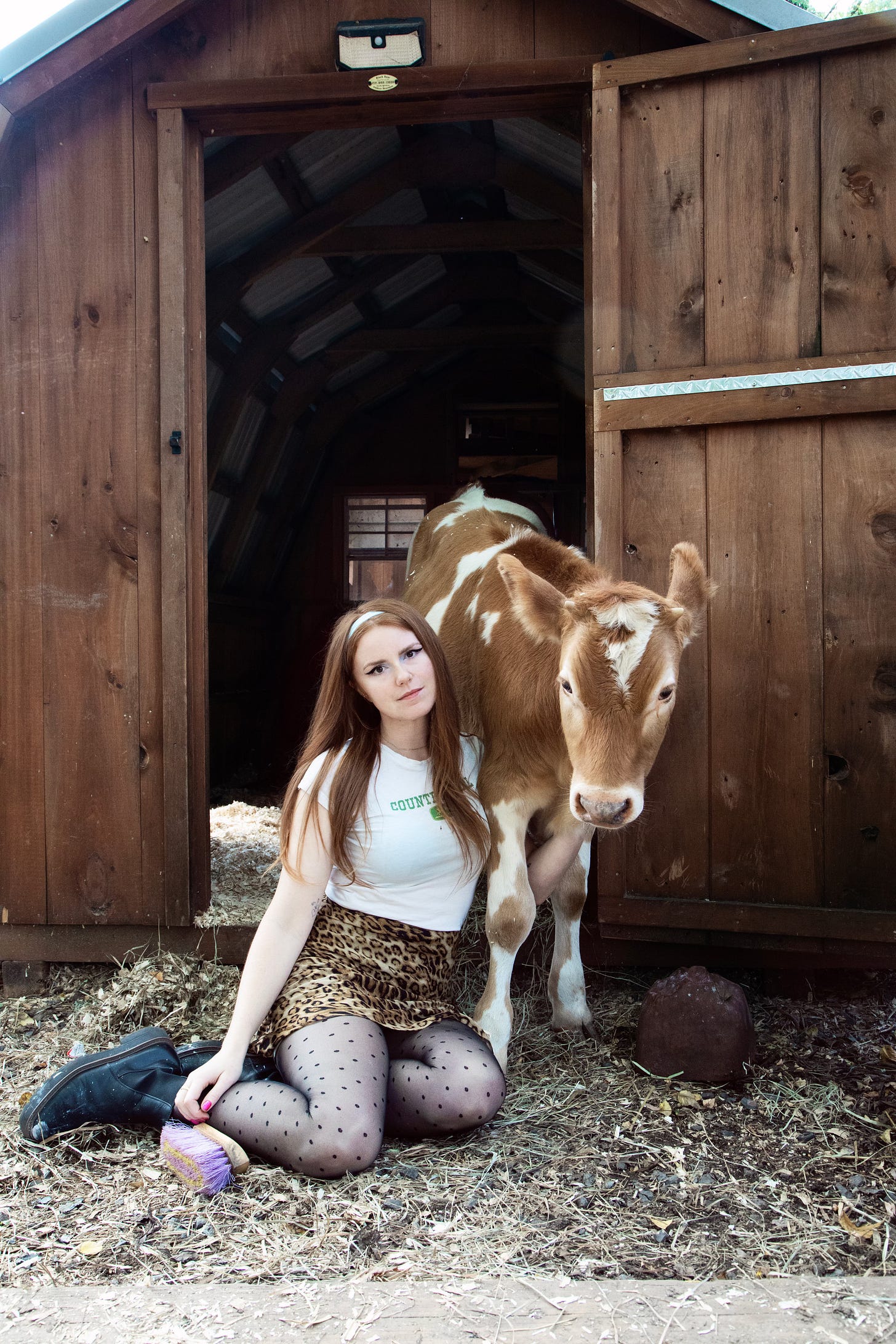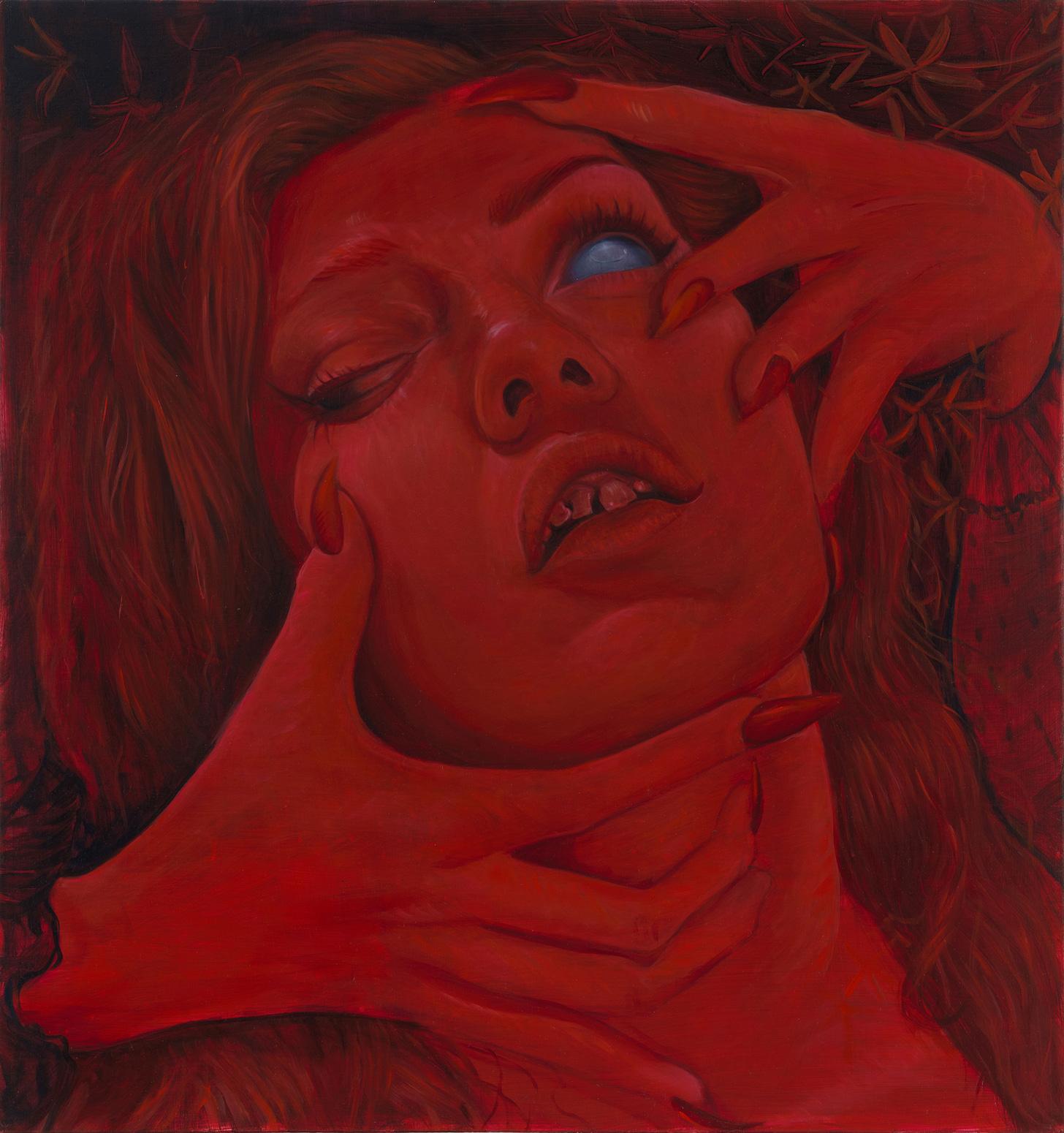7 Questions With the Art Daddy with Samantha Joy Groff
Hot houswife and daddy finally did a collab...
Over the past three years, Samantha Joy Groff has been making waves in the art world. A graduate of Yale’s MFA program, Groff found success during a particularly precarious moment—emerging in the post-COVID-19 landscape as the art market underwent significant shifts. Despite these challenges, she has steadily carved a path that highlights her talent at every turn.
Groff’s paintings create lush, immersive canvases that explore profound themes. Her most recent show was at Prophecy of the End at Nicodim in October. For her 2024 show at Half Gallery, she presented a body of work inspired by Diana, the Roman goddess of the hunt. These paintings also have a supernatural element that is present within them. The women depicted in this series are often in wooded landscapes at various times of the day and can be seen interacting with various animals.
The artist and her friend.
Deeply rooted in the traditions of portraiture and representations of women, Groff’s work simultaneously offers a contemporary perspective. Her paintings delve into the complexities of rural life, feminine power, and the intricate relationship between humanity and nature. Additionally, her upbringing in a Mennonite community in Pennsylvania remains a pervasive influence throughout her art making process. Groff earned a BFA in Integrated Design from Parsons and a BA in Film Studies from The New School—elements of which can be seen in her paintings. She made her debut in 2022 with a solo show at Martha’s Contemporary in Austin, Texas, followed by her Los Angeles debut at Nicodim Gallery. In 2023, she exhibited for the first time at Half Gallery in New York City.
Recently, Groff sat down with Art Daddy to discuss her grad school experience, the biggest challenges artists face today, and, of course, what an “art daddy” means to her. Keep reading to learn more!
The Art Daddy: You're a painter working within the confines of the art market today with an MFA from Yale no less. Given where things are in the art industry, and the success you have had so far, from your perspective as a professional artist, from when you first started out through today, what are some of the biggest challenges that you and your peers are facing at this moment?
Samantha Groff: The most pressing challenge we're currently facing seems to be the market. I entered into the commercial art world as an emerging artist during what felt like the tail end of a heightened market. It's now uncertain what the future holds. Unlike some older artists, or those who've been showing for longer, I don't have the benefit of years of experience seeing how the art market fluctuates, with figuration falling in and out of favor, and so on. Not to mention the uncertainty in our country at the moment.
Groff, Hunter’s Wife. Image courtesy of the artist.
Another challenge, though it may seem trivial and feels dirty acknowledging, is the influence of Instagram and influencer culture on the contemporary art scene. Laura Pitcher discusses this in a Dazed article. It does seem that galleries are increasingly showcasing artists with large follower counts, which isn’t unique to the artworld. The OnlyFans-esque display of bare ass and tits next to paintings—has become so commonplace that it’s now mundane, and yet it’s still rewarded in the attention-driven economy of the online art world.
I think a lot of my peers are conflicted on how to navigate it…I’ve found through an exaggerated persona, I make online self promotion tolerable. In another sense, I think constantly bombarding your mind with images all day can affect your personal art practice. How easily we are influenced by images. I literally pay for an app blocker on my phone so I’m not tempted to doom scroll.
AD: There has been a lot of recent conversation within the art world and beyond about the pros and cons of attending an MFA program. You attended one of the best programs in the country for painting. What was your experience like? And do you think there are more benefits or drawbacks to attending one?
SG: My MFA was during COVID, so it wasn’t the typical experience but I will try to be as transparent as possible. The majority of the courses were online and had extremely limited graduate opportunities.
However, I owe much of my career success thus far to my MFA experience because it gave me the platform to be seen in the art world. Not all grad schools have that sway frankly. Just by putting my name on their website, I was suddenly hearing from people. Before grad school, I was working a corporate job and not painting. I didn’t study fine arts in college because, coming from a working-class background, college was how to get a white-collar job.
The artist in her studio.
The main and most talked about drawback of grad school is the price. Many people go into debt to attend an MFA, and that is a serious thing to consider when attending. My schooling was fully funded and I kept my full-time corporate job during the first year when classes were online so I was better set up for maintaining a studio practice post-grad.
Hilary Harkness talks about this online, that only a select few grad schools open doors for artists, and the rest are ridiculously overpriced. Overall, I think it depends on the individual, and what their goals are. If studio representation is the end goal, some artists seem to make it work just by living and working in New York or LA and having the means to keep a studio there. They also may have connections I am not privy to which circumvent the need for grad school’s potential network.
However, having access to faculty and school resources is a benefit to push your work further without the scene or commercial influence. And to me that is invaluable. I was lucky enough to receive one studio visit from Rob Storr before he retired. How many artists can say Rob Storr took the time to look at their work? In the same vein, where else can you get brutally shit on in a critique? It’s better to hear it then and get your legs for it, for if/when eventually you receive a bad art review for the whole internet to read.
AD: What is one artwork or artist in your personal collection that people might be shocked to know you own?
SG: I love photography, so I collect prints. It’s not shocking that I own a print by Natalie Ivis featuring her mom’s red velvet couch, red-taloned feet, and a pet squirrel. Natalie and I are both weird animal lovers. This winter, I finally got to meet the squirrel and her mom on the same red couch down in Florida. The squirrel, also named Sam, would climb me like a tree and jump out of the cupboards onto my shoulder, it was a total thrill.
Groff, Salvation Lever. Image courtesy of the artist.
The shocking work I own is a funny painting by my ex and fellow Yale grad that I bought off an eBay auction. You’d never guess he made it–except for his very memorable signature at the bottom right corner of the painting.
It was from years ago when he had just gotten out of prison and he was making these kinds of pop-art, stencil works that someone found at a thrift store. In addition to the eBay listing, somebody began pestering him over email to claim the piece unrelentingly. So I finally bought it for him off eBay to solve the problem. After all that, he still didn’t put a ring on my finger. I don’t know why I thought that would somehow prove my love, but I still have his kitschy Marilyn Monroe painting as a keepsake. Needless to say, I learned the hard way— if he wanted to he would, ladies.
AD: What’s one thing you are obsessed with right now?
SG: I am on a facebook group dedicated to owning pet skunks which has always been an obsession of mine. I can get a permit to own one where I live in Pennsylvania, so it’s very tempting.
AD: What are you reading and listening to right now?
SG: I’m reading the Goldfinch by Donna Tartt.
Here are few of my favorite Daddy themed songs from my neck of the woods that I have on repeat:
“Daddy’s Lambo” by Yelawolf - This feels autobiographical when I'm in the art scene especially in LA. People in LA have less hang ups about displaying their wealth, unlike the Carhartt cosplayers of NYC. It's always interesting to experience how the other side lives.
AD: What’s one piece of advice you wish you had when you were younger?
SG: Don’t waste time on people who don’t reciprocate your energy. As cliche as that sounds, I wasted so much time overcompensating for low-effort people who wouldn’t meet me close to the middle. My needs were never important and I didn’t have any boundaries.
Groff, Prophecy. Image courtesy of the artist.
I have been undoing years of people-pleasing in my past. I spent the majority of the first 25 years of my life operating out of extreme fear and the feeling of unworthiness. I didn’t think about my dreams and goals because I was in codependent scenarios that exhausted all my emotional energy. I finally grew a spine but wish I had the courage to advocate for my younger self.
AD: Define what an art daddy is to you. And who is your art daddy?
SG: Art Daddies come in all shapes and sizes, but I like mine paternalistic and honest. I prefer a stern hand because I’m a bit domineering. I like to top, tops or so I’ve been told.
An Art Daddy has my best interests at heart but is willing to tell me the hard things at any moment. They push me to be my best, and won't let me privately worry too much. They evangelize my work to people who are non-believers and protect me from missteps. The application for an art daddy in my life is currently open.


